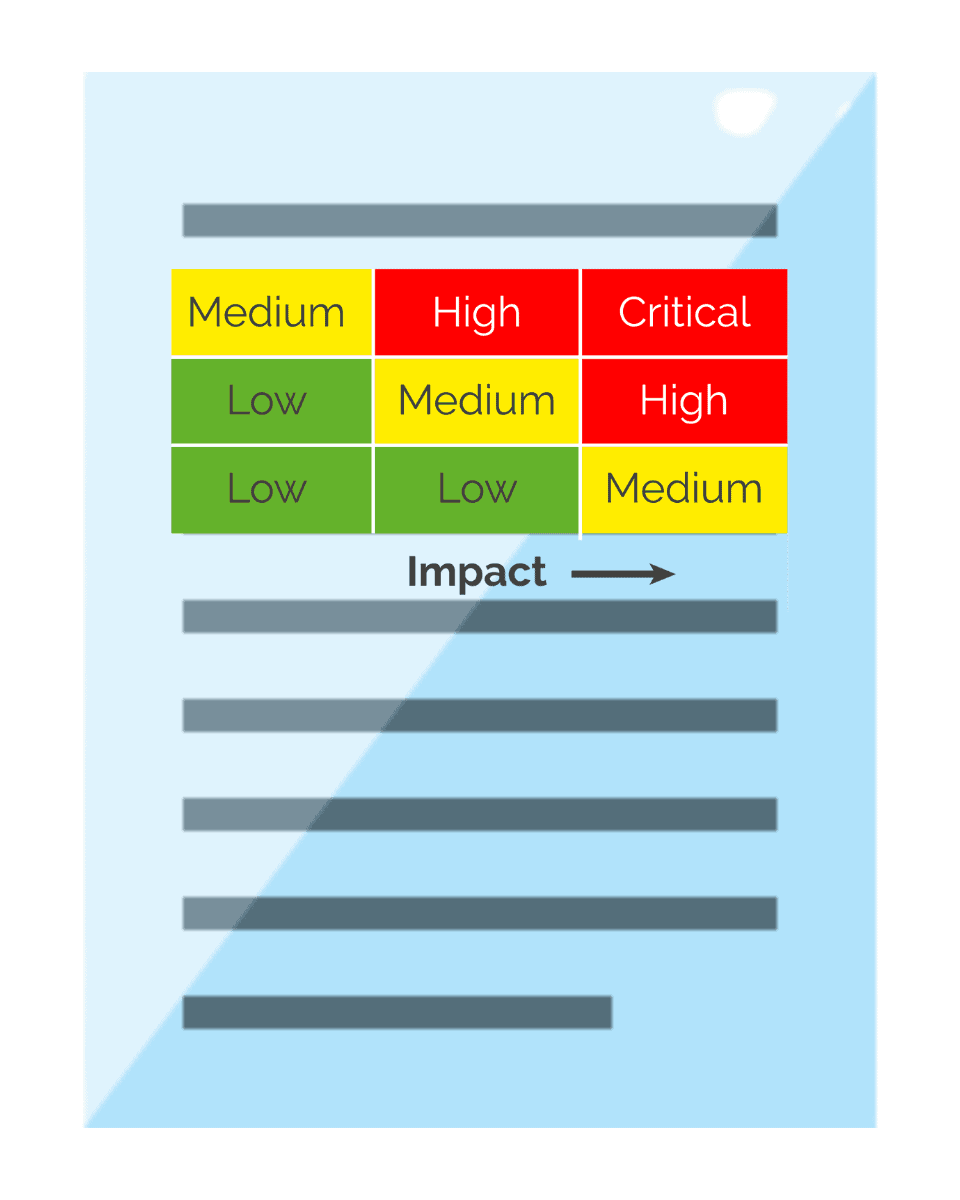Have you heard of terms such as ransomware, stolen credentials, and data leakage? If yes, these are terms we often hear that are associated with cybercrime and business.
Unfortunately, many businesses have fallen victim to these attacks, past and present.
According to a recent statistic, the average cost of a data breach to a small business can range from $120,000 to $1.24 million.
Free Security Policy Templates
Get a step ahead of your cybersecurity goals with our comprehensive templates.

It is not unreasonable to conclude that these and other statistics related to cybercrime will continue. To protect your organization from becoming a cybercrime statistic, you will need to be prepared and vigilant.
One method to achieve this is to conduct a vulnerability assessment.
In this article, I will explain what a vulnerability assessment is, why you need it, how to implement it, and how you can automate the assessment to continuously protect your environment from cybercrime.
What Is A Vulnerability Assessment?
 A vulnerability assessment is the process of identifying vulnerabilities and classifying risks in an infrastructure.
A vulnerability assessment is the process of identifying vulnerabilities and classifying risks in an infrastructure.
The assessment also seeks to identify weaknesses in all connected systems to determine the most effective security measures.
In addition, it is important to note that the assessment is just one component of ongoing vulnerability management and is usually a one-time evaluation.
The output of the assessment sets the tone for continuous vulnerability management which in turn will reduce the overall risk to your organization over time.
Vulnerability Assessment VS Penetration Testing
As you prepare for a vulnerability assessment, it is important to understand how it compares to assessing the effectiveness of your security through penetration testing.
The key difference is that a penetration test is typically more targeted and comprehensive, with the goal of exploiting a system with the permission of the business.
The vulnerability assessment, on the other hand, is intended to identify all risks and discover weaknesses, and vulnerabilities across all assets that are in scope for the assessment.
Learn More: Vulnerability Assessment VS Penetration Testing
Regardless of the differences between the two, they can both be integrated to support the goals of your organization’s vulnerability management program.
Let’s now explore the various types of vulnerability assessments your teams can perform.
Types Of Vulnerability Assessments
When preparing for a vulnerability assessment, you should first consider the location, asset type, and asset function to be scanned on your network.
In this section, we are going to describe the various types of vulnerability assessments and how you can plan the assessment for each type.
- External Scan – This type of scan targets assets or external network addresses that are exposed to the internet. This scan is usually performed without credentials to simulate an attacker’s access to your systems.
- Internal Scan – This scan provides more details and comprehensive results. The scanner is typically configured with a dedicated account or credentials that has read or privileged access to the asset’s internal file system.
- Network Assessment – The purpose of this assessment is to provide a comprehensive report of your IT infrastructure and how your assets interconnect. The results of the assessment can be fed into a vulnerability scan or penetration test to measure the effectiveness of your network security defenses.
- Host-Based Assessment – The host assessment provides vulnerability data on a specific network host, such as a desktop, laptop, or any other specific endpoint. The assessment is typically performed with an installed host agent communicating with a server to gather the results.
- Web Application Assessment – This scan type targets specific websites to detect flaws in code or poor security hygiene. The value of this assessment is that it can be performed during the lifecycle of the web application or externally scanned with login credentials to the application.
- Wireless Assessment – As the name implies, this scan assesses your network wireless infrastructure for weak SSIDs and other security flaws that an attacker can exploit.
- Database Assessment – Discovers and identifies database instances on the network. Provides information on vulnerabilities associated with database versions and their susceptibility to an attack.
The Vulnerability Assessment Process Explained
The vulnerability assessment process is one step in the entire vulnerability management lifecycle.
In most cases, an asset identification assessment is completed before the vulnerability assessment. Without this information, it will be difficult to ensure all devices are in scope for the assessment.
Let’s now review the main components of the process:
- Setting Up the Scanner – The scanner is the engine that drives the assessment. Several vendors provide a server image that can be used to create an on-premises scanner appliance. Other vendors have cloud-based scanners that can scan your external environment. Select a scanner based on your assessment needs, i.e., host-based, network, wireless, web application, credential scans, internal or external scans.
- Scanning For Vulnerabilities – For the scanner to work, it first needs to know what and where to scan. This information can be a list of server names, a list of specific IP addresses, or a complete list of IP address ranges to scan. The scans are typically scheduled during business hours and the raw scan results are stored on the system for the IT teams to review at a later time.
- Analyzing Scan Results – The output of the scans in most cases is typically analyzed by the team who is responsible for the scanner appliance. Once analyzed, the results are distributed to the responsible teams for review and remediation – based on SLAs documented in your vulnerability management policy.
- Writing A Vulnerability Assessment Report – Modern scanners today are capable of creating various report types, such as executive-level reports. Depending upon the type of assessment, a vulnerability report template can be used for quick input of the results.
- Presenting Results to Stakeholders – Presentation of the vulnerability results is important. Remediation for a vulnerability may require an investment to update a legacy program. The stakeholders would be the decision-makers in this type of situation. Raw log results should not be communicated to stakeholders. Clear key performance metrics, such as mean time to remediate that illustrate risk-based vulnerability management trends that impact the business are valuable to your stakeholders.
- Remediation of Vulnerabilities -Remediating vulnerabilities helps burn down the amount of vulnerabilities. The application or business owner is accountable and should direct the vulnerability remediation efforts.
The timeline for remediation should align with the approved SLAs documented in your vulnerability management policy.
Now that we have the steps to conduct the assessment, let’s note the challenges in the next topic and methods to overcome them.
Benefits Of Conducting Vulnerability Assessments
In this section, I’ll explain 3 top benefits of vulnerability management your organization can attain including:
- One primary benefit of conducting regular vulnerability assessments is that they provide quantifiable metrics that describe the risk level of your vulnerability programs. With this information, your teams can develop strategies to remediate and patch systems before they can be exploited.
- Increases efficiency and improves overall security effectiveness. A consistent process of assessing and remediating vulnerabilities reduces technical debt and allows your teams to allocate resources properly and respond quickly to threats.
- Improves credibility within your industry and stakeholders. Potential business partners and customers are likely to partner with organizations that take security seriously. This can lead to increased revenue and profits.
To attain the benefits listed, there needs to be a strategic plan or document that directs the efforts. This plan is documented in a policy, let’s note this in the next section.
Why You Need To Conduct Regular Vulnerability Assessments
Conducting regular and consistent vulnerability assessments is a winning formula to counter attacks from hackers. Threat actors are continuously scanning your networks for open ports, default passwords, and unpatched vulnerabilities.
To reduce risk to your business, your security teams must be offensive to stay ahead of the threats, and defensive to protect your network. Simply checking the box to satisfy an audit is an open invitation for an attack that could lead to catastrophic results.
Planning and conducting regular vulnerability assessments leads to short- and long-term vulnerability management benefits for your security programs. Let’s take a look at these in the next section.
Vulnerability Assessment Policy
The purpose of the vulnerability assessment policy is to establish and document the strategy for the assessment. This policy should be readily available, and clear, and lays out the strategy of the assessment policy from beginning to end.
The policy should fit the needs of your organization, not another. However, utilizing a vulnerability report template to create your policy is less daunting and allows you to fill in the blanks per se’ with your organization’s information.
The basic policy elements are listed below:
- Purpose – Briefly explain why you need it
- Scope – What the policy will evaluate, i.e., Network, Host, Wireless
- Policy – Define and explain the strategy, i.e., describe what will be assessed, how it will be done, who, and when.
Once the policy elements are defined and approved, the next step is to learn how to conduct a vulnerability assessment.
Challenges With Vulnerability Assessments
- Lack of an asset inventory assessment – Can’t scan what you don’t know. How to overcome: A complete inventory assessment is needed to ensure all assets are accounted for and to determine which assets are in scope for the assessment.
- Ad hoc scanning – Lack of scheduling, hit or miss scanning instead of a continuous scanning approach.
How to overcome: Develop a continuous scanning approach. Ensure scans are scheduled regularly without impacting business operations. - Lack of prioritization – Focusing on remediation without factoring in the value of the asset or system.
How to overcome: Align your remediation strategy with a ranking per asset. Prioritize remediation of systems critical to the business first.
Another strategy that will increase the efficiency of your vulnerability assessment process is automating vulnerability management.
How to Automate Vulnerability Assessments
Including automation in your vulnerability assessment process is a major benefit to the overall vulnerability management lifecycle.
The benefits are:
- Faster assessments
- Continuous evaluation and insight into the risk of a vulnerability
- Continuous discovery of new vulnerabilities
- Real-time notification and reporting
- Automated patching
- Organize asset inventory with the ability to prioritize
- Cost reduction
Wrapping Up
In this article, we have defined and explained the importance and process of a vulnerability assessment.
We learned how the assessment supports the lifecycle of the vulnerability management program by the following steps – initiating an asset inventory, creating a vulnerability assessment policy, and detailing methods to enforce the policy.
We also provided how you can go about selecting a scanner and present the scan results to your stakeholders.
We reviewed how you can overcome the common pitfalls that will enable you to streamline your vulnerability assessment processes.
Finally, we discussed automating features of the vulnerability assessment process and how it fits into your overall vulnerability management program.
By following the steps in this article, you now have the information to succeed in developing a vulnerability assessment strategy that supports your organization’s vulnerability management program.
Article by


